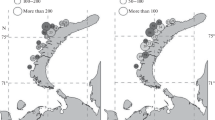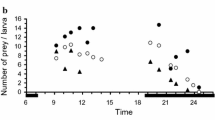Abstract
The growth rate of mackerel, Scomber scombrus, larvae was calculated by analysing mean cohort length over time. The study took place on the central spawning ground of mackcrel in the Celtic Sea (Great Sole Bank) in April 1986. In order to minimize horizontal catch variability, repeated small-scale sampling with the “Mocness” plankton net was undertaken close to a satellite-tracked drifting buoy during a period of 78 h. Eighteen samples from nine hauls distributed over the whole sampling period were considered. One hundred larvae per sample were measured using a semi-automatic method. The proportion of larger larvae was significantly higher in night catches than in day catches. Independently calculated growth rates were 0.18 mm d-1 for day catches and 0.14 mm d-1 for night catches. This difference was not statistically significant. However, confidence in the calculation of growth rate, computed from night sampling, was much higher than that for day sampling. This may result as an effect of avoidance behaviour by larvae in daylight. Thus, night sampling seems to be a more reliable tool in the study of larval growth and should be used more extensively than daylight sampling.
Similar content being viewed by others
Literature cited
Bridger, J. P. (1956). On day and night variation in catches of fish larvae. J. Cons. int. Explor. Mer 22: 42–57
Clutter, R. I., Anraku, M. (1968). Avoidance of saplers. In: Trainter, D. J. (ed.) Reviews on zooplankton sampling methods, part I. In: Zooplankton sampling. Monogr. oceanogr. Methodol. (UNESCO) 2: 57–76
Colton, J. B., Jr., Honey, K. A., Temple, R. F. (1961). The effectiveness of sampling methods used to study the distribution of larval herring in the Gulf of Maine. J. Cons. int. Explor. Mer. 26: 180–190
Coombs, S. S., Lindley, J. A., Fosh, C. A. (1983). Vertical distribution of larvae of mackerel (Scomber scombrus) and microplankton, with some conclusions on feeding conditions and survey methods. F.A.O. Fish. Rep. 291: 939–954
Houde, E. D. (1986). Potential for growth, duration of early life stages and regulation of recruitment in marine fish. Int. Counc. Explor. Sea Conn. Meet. Biol. Oceanogr. Conn) L: 28:1–19
Kendall, A. W., Jr., Gordon, D. (1981). Growth rate of Atlantic mackerel (Scomber scombrus) larvae in the Middle Atlantic Bight. J. Cons. int. Explor. Mer 178: 337–341
Ndomahina, E. T. (1988). Light microscopic observations of fish larval otolith microstructure (their preparation, interpretation and application in growth studies). Ph.D. Thesis, Univ. Kiel
Peterson, W. T., Ausubel, S. J. (1984). Diets and selective feeding by larvae of Atlantic mackerel Scomber scombrus on zooplankton. Mar. Ecol. Prog. Ser. 17: 65–75
Ricker, W. E., Foerster, R. E. (1948). Computation of fish production. Bull. Bingham oceanogr. Coll. 11: 173–211
Röpke, A. in press. Small-scale vertical distribution of ichthyoplankton in the Celtic Sea in April 1986. Meeresforschung
Saville, A., Schnack, D. (1981). Some thoughts on the current status of studies of fish egg and larval distribution and abundance. Rapp. P.-v. Reun. Cons. perm. int. Explor. Mer 178: 153–157
Sette, O. (1943). Biology of the Atlantic mackerel (Scomber scombrus) of North America. Part I: Early life history, including growth, drift, and mortality of the egg and larval populations. Fishery Bull Fish Wildl. Serv. U.S. 38 (50): 148–237
Shepherd, J. G., Cushing, D. H. (1980). A mechanism for densitydependent survival of larval fish as the basis of a stock — recruitment relationship. J. Cons. int. Explor. Mer 39(2): 160–167
Wiebe, P. H., Burt, K. H., Boyd, S. H., Morton, A. W. (1976). A multiple opening/closing net and environmental sensing system for sampling zooplankton. J. mar. Res. 34(3): 313–326
Author information
Authors and Affiliations
Additional information
Communicated by O. Kinne, Oldendorf/Luhe
Rights and permissions
About this article
Cite this article
Röpke, A. Day/night differences in determination of growth rate of mackerel Scomber scombrus larvae during a patch-study in the Celtic Sea. Mar. Biol. 102, 439–443 (1989). https://doi.org/10.1007/BF00438344
Accepted:
Issue Date:
DOI: https://doi.org/10.1007/BF00438344




